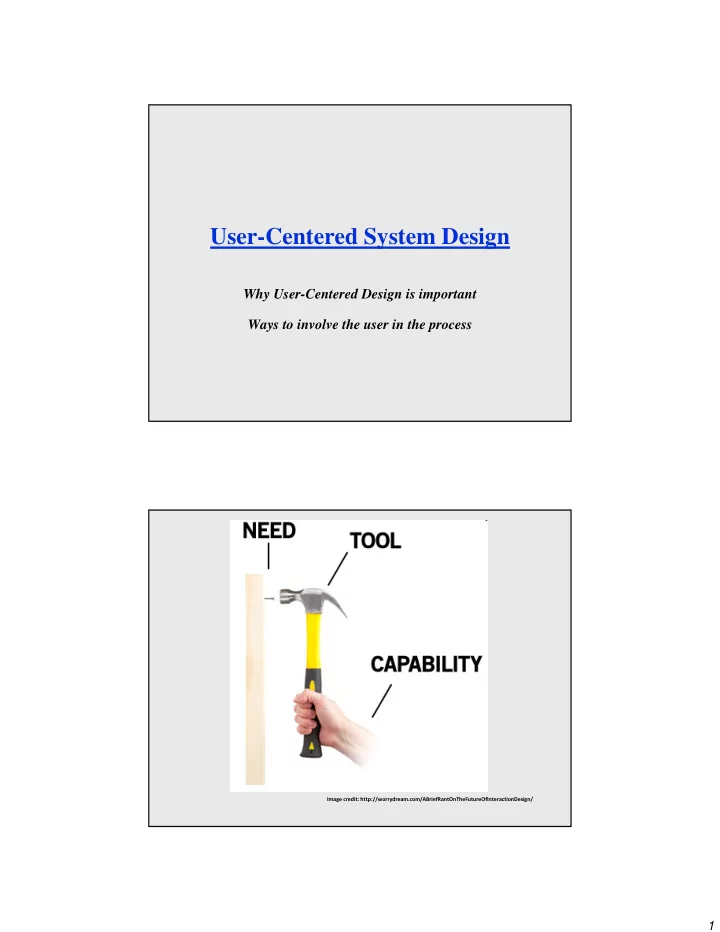

User-Centered System Design Why User-Centered Design is important Ways to involve the user in the process Image credit: http://worrydream.com/ABriefRantOnTheFutureOfInteractionDesign/ 1
System-Centered Design http://dilbert.com/strip/1989-09-06 System-Centered Design What can be built easily on this platform? What can I create from the most easily available tools? What technology do I as a programmer find interesting to work on? ���������������������������� Evan Golub / Ben Bederson / Saul Greenberg 2
User-Centered Design http://dilbert.com/strip/1994-09-30 Evan Golub / Ben Bederson / Saul Greenberg User-Centered Design The user should always be in your thoughts. – Remember, part of generating real tasks was finding real potential users… Good design will consider the user’s: •Abilities •Needs •Context •Tasks Golden rule of interface design: “Know The User” Evan Golub / Ben Bederson / Saul Greenberg 3
Involve the Users Talk to potential users (seems obvious but isn’t). Interview users more formally (find out more about their culture, expectations, abilities, surroundings). Explain what you are planning and welcome comments, criticisms, suggestions for change. Have them try “beta” versions early enough that changes can still be made (not simply shaking out the coding bugs). Can even have them be part of the design team! User Diversity It is important to note that the users that you think will benefit form what you are creating might only be a subset of the actual set of users that will benefit from, or make use of, your technology. Some assistive technologies that were “meant” for users with hearing or vision impairments are used by “everyday” users today. Evan Golub / Ben Bederson / Saul Greenberg 4
User-Centered System Design ... is based on understanding the domain of work or play in which people are engaged and in which they interact with computers, and programming computers to facilitate human action… Three assumptions • The result of a good design is a satisfied customer. • The process of design is a collaboration between designers and customers . The design evolves and adapts to their changing concerns, and the process produces a specification as an important byproduct. • The customer and designer are in constant communication during the entire process. From Denning and Dargan, p111 in Winograd, Ed., Bringing Design to Software, Addison Wesley Evan Golub / Ben Bederson / Saul Greenberg One Approach: Participatory Design The user Problems is just • our intuitions could be wrong like me! • interviews etc. might not be precise • designers cannot know the user sufficiently well to answer all issues that come up during the design Potential Solution Designers should have access to pool of representative users. These are the “end-users” themselves, not their managers or union reps, etc. Evan Golub / Ben Bederson / Saul Greenberg 5
Participatory Design Users become first class members in the design process –active collaborators vs passive participants Users considered subject matter experts –know all about the work context Iterative process –all design stages subject to revision Evan Golub / Ben Bederson / Saul Greenberg Participatory Design Participatory Design: Up side • users are excellent at reacting to suggested system designs – designs must be concrete and visible • users bring in important “folk” knowledge of work context – knowledge may be otherwise inaccessible to design team • greater buy-in for the system often results Down side • hard to get a good pool of end users – expensive, reluctance ... • users are not expert designers – don’t expect them to come up with design ideas from scratch • the user is not always right – don’t expect them to know what they want Evan Golub / Ben Bederson / Saul Greenberg 6
Emmy-Winning Interactions The “Do Not Touch” button that was developed with Kidsteam as part of the particpatory design process. Nickelodeon won the 2013 Emmy for Outstanding Creative Achievement In Interactive Media – User Experience And Visual Design for their Nick App, which features it. The button was specifically recognized for its, “array of disruptive comedy and surprises.” Evan Golub / Ben Bederson / Saul Greenberg Levels/Methods for involving the user User • Uses system after deployment. Tester • Tests system after development, before deployment Informant • Helps during development – perhaps by critiquing designs, participating in interviews, observations of current practices, etc. Design Partner (full PD) • Equal partner - Allison Druin, UMD (CHI 2000) Evan Golub / Ben Bederson / Saul Greenberg 7
When involving the user… Beyond talking to users (still surprising how many designers don’t seem to much) and simple interviews (to try to discover user culture, requirements, expectations, etc.) you can also… – Use contextual inquiry where you interview users in their workplace, as they are doing their job. – Go to them along the way and explain your designs and describe what you are planning to do. You can get input at all stages of the design and should try to stay open to the idea that all designs are subject to user-inspired revision. – When meeting with clients, it’s important to have visuals and/or demos since people can react far differently to them versus with verbal explanations. Evan Golub / Ben Bederson / Saul Greenberg What you now know about… User centered design design is based upon the real needs, tasks, and work contexts of real users Participatory design bringing the end-users in as first-class citizens in the design process Evan Golub / Ben Bederson / Saul Greenberg 8
Reading Required: http://hcibib.org/tcuid/chap-2.html Optional readings after this week are “Designing the User Interface” Chapters 3 and 4 (guidelines, principles, & theories and design processes in general). A specific-interest optional reading is “sections you think sound interesting” in Chapter 2 of DTUI on universal usability. Evan Golub / Ben Bederson / Saul Greenberg 9
Recommend
More recommend